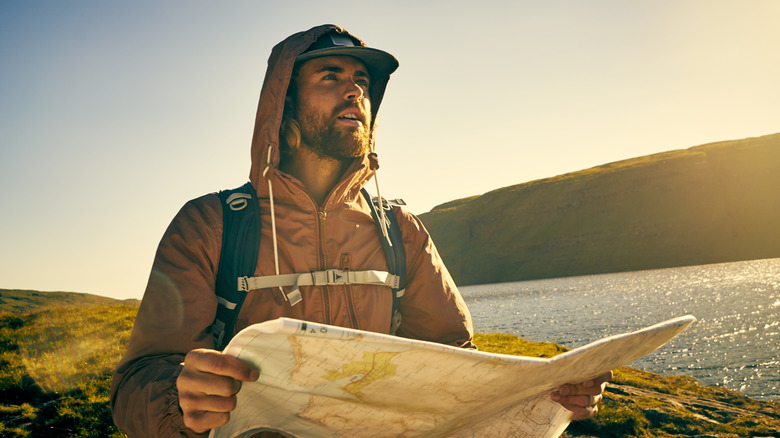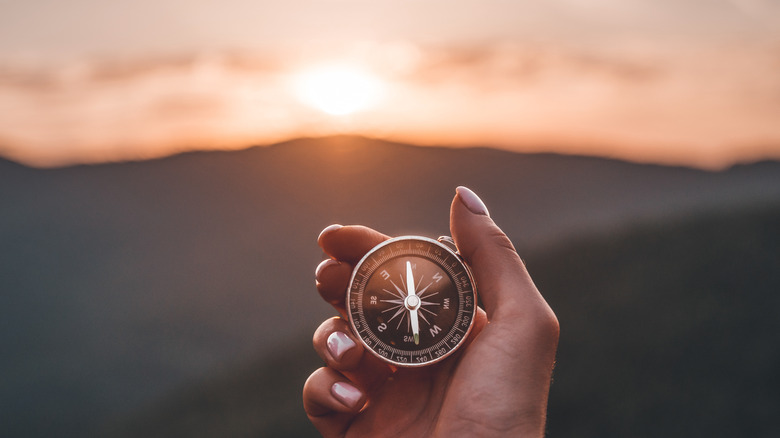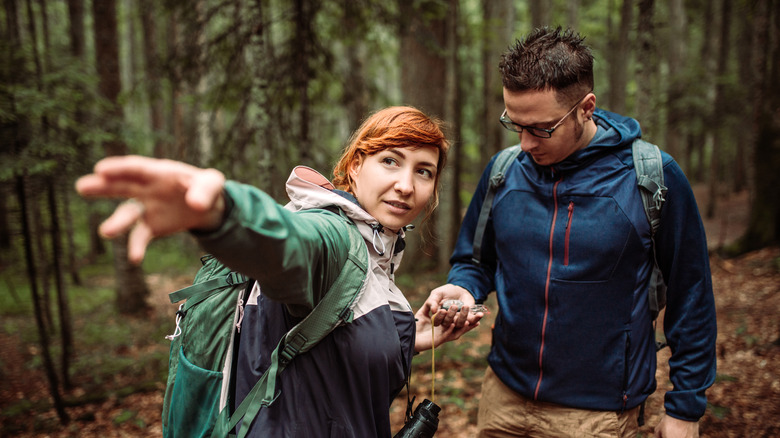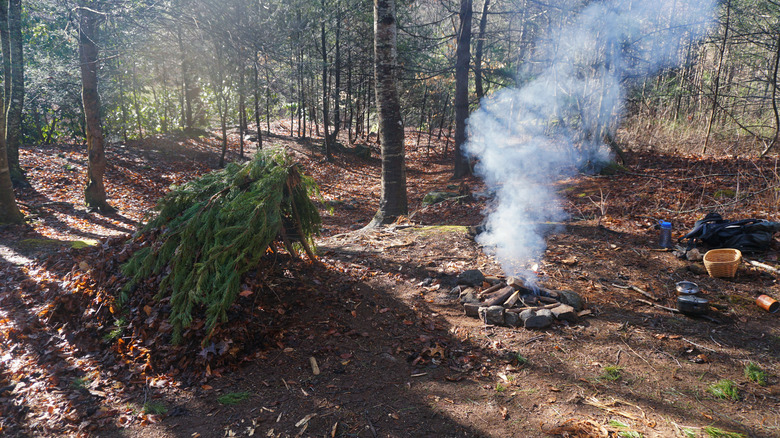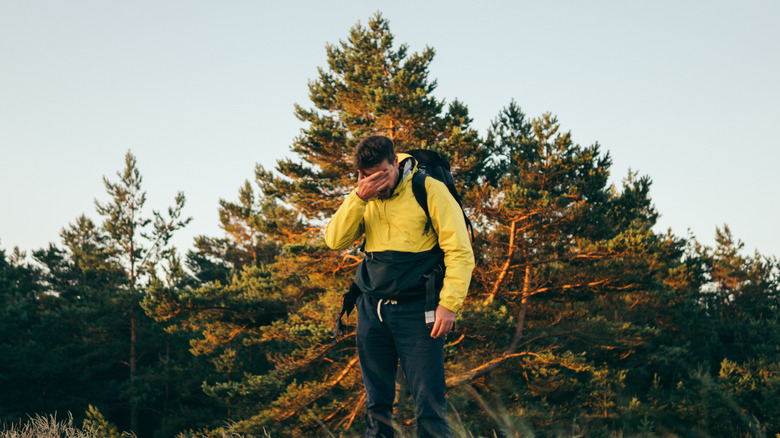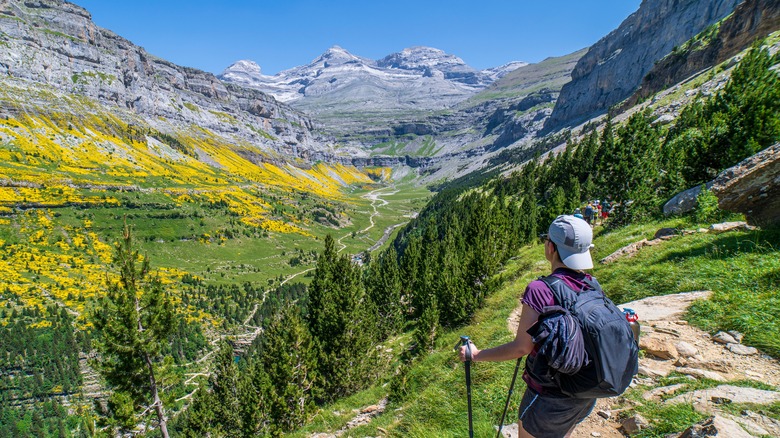What To Do If You Get Lost On A Hike
More people get lost hiking than you'd probably imagine. According to National Geographic, there were 46,609 search and rescue cases from 2004-2014 across all U.S. national parks. And these cases weren't restricted to novice hikers. You can get lost while hiking for plenty of reasons. Incorrectly estimating the time and distance of a trail, going off-trail, following a faulty or old map, missing trail signals, and hiking after dusk are all common reasons for losing your bearings when hiking.
Finding yourself lost in the wilderness can be a terrifying ordeal. While it may feel natural to continue hiking, in a trial-and-error type of way, in the hopes of finding a quick solution, it's imperative to remain calm, conserve your energy, and keep your wits. When you become lost when hiking, you can easily make a bad situation worse by panicking.
How you react to the situation can impact your mental state, quickly drain your energy, dictate your decision-making, and make it more difficult for search and rescue teams to find you. Today, we'll go over what to do if you get lost while hiking. In some cases, a little insight could be the difference between life and death.
The right equipment if you do get lost
In the data supplied by National Geographic, the largest percentage (42%) of the 46,609 search and rescue cases actually involved day hikers. This percentage was nearly four times the amount of search and rescue cases for overnight backpackers, the second-highest group requiring assistance. And the reasoning is pretty simple: the lack of equipment and provisions.
Understandably, if you're day hiking, you probably don't consider taking extra clothes, a tarp or 55-gallon trash bag, a compass, a high-quality topography map, a flashlight, or waterproof matches. Instead, you may take an extra sweater for layering, food and water for the day, and your cell phone. However, even on a day hike, a good rule of thumb is to pack as though you may need to spend the night, which includes the aforementioned items.
If nothing else, we'd definitely suggest bringing a compass and map, even on short day hikes. Many of us have become entirely reliant on our cell phones and their GPS capabilities. After all, what do we do when we're usually lost? We simply look at a GPS map on our phones. However, there's no guarantee you'll have cell phone service (and a good chance you won't), and even standalone GPS devices aren't invulnerable to mechanical or battery issues. When lost, a compass and map may be your most reliable navigation system.
STOP protocol and positive mentality
Despite all your preparation, route planning, and hiking experience, you may still find yourself lost. While this may be a scary realization, it's absolutely crucial not to panic. Panicking can affect your thinking and problem-solving skills, leaving you even more vulnerable. To help prevent panic, you should follow a simple acronym called STOP: stop, think, observe, and plan.
First, you should STOP walking. By continuing to walk after realizing you're lost, you may become "more lost," or farther from a rescue team's search area, due to panic and irrational thinking. So, stop, take a few deep breaths, take a sip of water, and calm down. After you're composed, then you can THINK clearly. What direction were you moving? Are there any landmarks you should be able to see? Don't move just yet. Just think.
After thinking, begin to OBSERVE. Take out your compass and map, set your directions, and identify landmarks you should be able to see. Consider your water, the weather, the time of day, and the needs of other group members.
Lastly, after observing your surroundings and considering your circumstance, PLAN. If possible, try to come up with a few plans before acting on one. If you believe you can arrive at a designated spot before nightfall, then go carefully and mark your route as you hike. If you're not very confident in your route, the best plan is to stay in place to be found.
Staying found if you become lost
As stated, staying put may be the best plan of action. If you've told someone you were hiking, where you were hiking, and when you expected to complete the hike, then a rescue team should be informed of your situation. However, you may need to shelter in place for the evening, and there are a few things you can do to "stay found" when lost. It's important to remember that common protocol dictates sending rescue teams during the day, so don't panic.
First, try to create a shelter of some sort. If you have a tarp or similar fabric, then make an angled shelter by draping the fabric over two branches. If you don't have a tarp, then consider creating a simple lean-to shelter using sticks. If you have matches or a fire starter, start a small ring fire after creating the shelter. Hypothermia due to cold and dampness is a common and serious problem, so creating a shelter and fire should be priorities. Also, by creating a comfortable space, you'll be apt to sleep better, which is also important.
Once it's daylight, continue creating camp and staying active. Your first task of the following day will be to locate a water source and boil the water. Even a plastic receptacle held high enough with branches over your fire can work. After, use anything that can reflect a signal mirror against sunlight and blow your rescue whistle in increments of three periodically.
Understanding lost person behavior
The reason 'don't panic' and 'shelter in place' are strong guidelines is because of an evidence-based phenomenon called "lost person behavior." Robert Koester is an author and the authority on lost-person behaviors. After writing the landmark 2008 book, "Lost Person Behavior: A Search and Rescue Guide on Where to Look — for Land, Air, and Water," Koester has had a 96% success rate when accompanying a search team or consulting with one.
Earning a Master of Science in Biology, with an emphasis in neuroscience, from the University of Virginia in the '80s, Koester then created the manual that search and rescue teams have followed ever since. In a recent interview with the University of Virginia, Koester emphasized the importance of "decision points." As an aside, Koester helps rescue children, persons suffering from dementia, as well as hikers. If you're lost, he'll find ya.
"This is where typically the trail got kind of confusing. Trail junctions, animal trails, and sharp turns all traditionally get people kind of going the wrong way," Koester said in his interview with UVA. "Then they keep going. This is what is called 'terrain analysis.'"
"Then the brain usually sends a couple of subconscious warning signals. Anxiety is starting to go up. Things aren't jiving between where they think they should be and what they're actually seeing." In an attempt to sum up what a whole book, manual, and Koester are saying, we can think of it like this: If you start to hike out when lost, you'll start to see familiar landmarks. However, it's because you're going in a circle and wearing yourself out. That's the cliff note of 'lost person behavior." That said, depending on the circumstance, you may need to self-rescue.
Tips for planning a self-rescue
If you're sure rescue isn't coming (or finding you) and provisions are drying up, then you certainly may need to self-rescue. To defy "lost person behavior," there are a few tips worth sharing. First, don't self-rescue in the heat of the day. Try to move camp and hike early in the morning, relax, then set back out around dusk. Time may or may not be on your side, but either way, dehydration will steal time faster than you can recuperate mileage.
The idea of not panicking really comes into play here. Hike slowly, Zen-like if you will, to conserve every bit of energy while you expel it. Mind your body. Don't let a small problem get bigger. When you eat, do so in the shade, and chill for 30 minutes or so. Your body can't digest effectively when hiking at the same time. And don't hike until exhaustion. Finally, whether it's tin foil, an aluminum can, or something else, make a flash mirror in your hand and walk with it. The glint goes a long way, and savvy rescue teams know it's a distress call.
Hiking is great. Exploration is great. But things happen, and hopefully, you'll just have a story to tell later if you do get lost. But as a final note, the best way to avoid getting and staying lost is to tell the preface of your storied hike, i.e., tell someone you're going hiking, where, and for how long. Happy trails.
